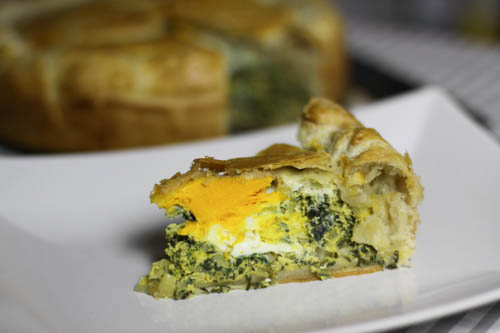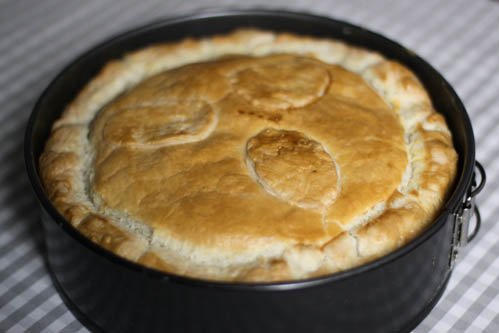Torta Pasqualina (Italian Easter pie)
 Friday, April 3, 2015 at 12:36PM
Friday, April 3, 2015 at 12:36PM 
Happy Easter everyone! For once I am doing absolutely nothing at Easter and I am loving it. Oh the joy of a lack of commitments and plans. But it means I have absolutely no excuse this year not to cook and post something in the spirit of the holiday.
I searched the internet for Easter dishes from around the world. I liked the look of this one most of all, since it contains one of my favourite combos: cheese and chard encased in pastry.
Torta Pasqualina means 'Easter pie' in Italian. This one comes from Liguria. Like most of the Easter recipes I looked at it contains a lot of eggs. Eggs are commonly associated with the Christian Easter tradition, a symbol of life and the resurrection.

The layers of pastry in this pie are also symbolic. Deborah Mele, of Italian Food Forever, says “this pie should have 33 three layers in the crust to celebrate the number of years that Jesus spent on Earth, but generally most recipes contain fewer layers.” Every recipe I looked at used a different kind of pastry. I like puff best, which is why I went with that, but I think the pastry in this recipe from Food 52 is probably more traditional.
I read about 7 or 8 recipes to arrive at this one. I wanted to try and keep it traditional, since it was my first time making it, so I didn’t add extra ingredients, like ham or mushrooms, though I might try that next time.
I took the pie into work and asked some of the Italians there to taste it. All said it tasted as it should and one person even said it tasted like his grandmother’s. Result! Surely the highest compliment an Italian can pay.
Serves 4-6 as a main with salad (depending how greedy you are). Makes around 10-12 slices as a snack.
Buona Pasqua

Ingredients
1 kg Swiss chard
2 tbsp olive oil
1 medium onion, finely chopped
Large handful fresh marjoram leaves (approx. 25g), finely chopped
¼ tsp ground nutmeg
100g Parmesan, grated
250g ricotta
8 eggs
Salt and freshly ground pepper, to taste
750g all butter puff pastry
Method
Preheat the oven to 180 degrees celcius and grease a 20cm springform cake tin.
Trim the Swiss chard, removing the stalk and central vein. Cook in a large saucepan of salted boiling water for approximately 5 minutes or until tender. Drain and place in muslin or a clean tea towel and ring out as much moisture as possible. This is to avoid a soggy bottom. Chop the chard.
Place a large saucepan over a low heat. Heat the olive oil a little then add the onion. Sweat for 5 minutes or until softened, stirring occasionally. Add the chard and fry for a minute or two longer. Pour into a mixing bowl and leave to cool.
When the onion and chard mix has cooled, add the marjoram, nutmeg, Parmesan, ricotta and mix. Beat 3 of the eggs and add to the mix. Season with salt and freshly ground black pepper, to taste.
Roll out one third of the pastry into a thin sheet, approximately 4mm thick. Place the cake tin over the pastry and cut around it to form a circular lid for the pie. Keep any excess pastry to make decorations (optional).
Roll out another third of the pastry into a thin sheet, approximately 3mm thick and 30cm wide. Place over the cake tin and gently press into the edges letting the excess dough hang over the edge. Do the same again with the remaining third of the pastry and this time position the second layer so it covers any parts of the tin that you haven’t covered with the first.

Put the filling in the pastry case. Make 4 wells in the mixture. Crack the remaining eggs one at a time and place in the wells. Season with salt and pepper.
Place the pastry lid on top and prink with a fork in the centre. Trim the overhanging pastry slightly so you have approximately 3cm all the way around. Roll it down until it reaches the top of the pie.

Beat the last egg and brush the top of the pastry with it. Place any pastry decorations on top and brush them with egg.
Bake for 45 minutes to 1 hour, until the pastry is crisp and golden.

 Vix |
Vix |  Post a Comment |
Post a Comment | 
Reader Comments